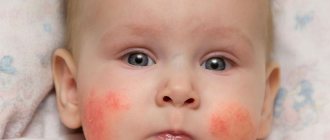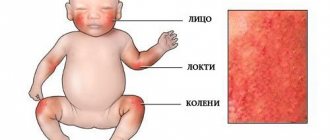What causes this immune response?
An allergy is a specific reaction of the human immune system to various substances, which occurs upon repeated interaction with a potential allergen. The process of occurrence of such a condition can be described as follows: when an allergen enters the body, it triggers the process of sensitization, that is, the human body becomes hypersensitive to this foreign substance (protein, lipids and other complex compounds).
The immune system “remembers” the foreign component and begins to actively produce antibodies. Upon repeated contact with this component, antibodies actively react with it, which leads to the release of histamines, which are the “culprits” for a number of negative manifestations in the body.
- Dog allergies in children are caused by various protein compounds that enter the environment along with animal waste products: urine, saliva, tears, excrement and genital discharge. The protein gets into the dog's fur and then spreads to carpets, furniture, dishes, children's toys, etc.
- Another important cause of occurrence is considered to be hereditary predisposition. If one of the parents has an allergy, it can also appear in the child, and if this disease is observed in both father and mother, the likelihood of such a reaction in the next generation increases to 70%.
- Allergies also occur in children due to immature immunity. This is why the child’s body begins to recognize the normal protein in an abnormal way, mistaking it for foreign, and begins to actively produce antibodies, which leads to symptoms.
Factors contributing to allergies
There are also a number of factors that provoke the development of this disease in a child:
- Various autoimmune diseases.
- Disturbances in the functioning of the endocrine system.
- Hormonal disorders.
- Having a history of diabetes mellitus.
- Disorders of the gastrointestinal tract.
What to do if a dog is the cause of an allergy in a child
As I mentioned, dogs are one of the animals most likely to cause allergies in a child, although any animal with fluff can potentially cause these problems.
Dogs shed, causing small scales to shed that become airborne and inhaled. It is diagnostic tests for allergies that will determine the main cause, so you should not make hasty decisions or make assumptions.
© shutterstock
Without contacting an allergist, it is difficult to imagine the cause, since the allergy may have developed through indirect contact, and the further appearance (sometimes it takes months/years to develop) of symptoms certainly surprises us. That is, from the development of the disease, any direct or indirect contact in closed or open spaces can cause a certain type of associated symptoms.
Symptoms
In its manifestations, a child’s allergy to a dog is very similar to reactions to other allergens.
Allergies have the following symptoms:
- nasal congestion;
- the appearance of a runny nose;
- frequent sneezing;
- bouts of dry cough;
- swelling of the eyelids;
- itching in the eyes;
- lacrimation;
- conjunctivitis;
- dryness and discomfort in the throat;
- inflammatory processes of the ears (otitis media);
- hearing loss;
- skin redness;
- skin rash;
- the appearance of skin itching;
- disorders of the stomach and intestines;
- anaphylactic shock;
- Quincke's edema.
Basically, allergies in children are manifested by symptoms such as frequent sneezing, watery eyes, excessive nasal discharge and skin rashes (especially in young children). You may even experience a sore throat. If such signs are present, it is necessary to stop the baby’s contact with the animal as quickly as possible. Also, the child should not touch objects of use.
Many parents have a completely normal question: how does an allergy to dogs manifest in children, so we present to your attention a photo in which a baby has a skin rash, as one of the above symptoms.
Causes
An allergy to a dog can arise from both direct and indirect exposure. The reason lies in a specific protein that is found in saliva, sebaceous glands, urine, genital secretions and particles of dead epidermis of the animal. When this substance comes into contact with a child's skin or respiratory tract, an immune response develops.
Not all children are allergic to dogs. Certain groups of children are most susceptible to it.
- Newborns or children with weakened immune systems. Doctors say that a child’s immunity is fully formed by the age of 3. However, in some cases, reactions to dogs can last a lifetime.
- Children with individual hypersensitivity. An immune response occurs to a specific breed or individual.
- Children with a genetic predisposition. Animal intolerance can be inherited by a child. However, it is important to remember that it manifests itself differently for all family members. For example, the mother may have watery eyes and a severe runny nose, while the baby may develop skin rashes or a severe cough.
In some cases, the dog is not the cause of the allergy. It only transmits pathogens of the immune response. During a walk, mites, lint, dust or pollen particles get on your pet's fur. To avoid negative reactions, it is advisable to bathe your pet after every trip outside.
Diagnostics
There are two ways to diagnose this condition of the body:
- Conduct a radioallergosorbent test . Thanks to it, the level of antibodies to various protein substances is determined in the blood serum and it is determined what provokes the occurrence of this disease.
- Carry out skin tests . This method consists of making small scratches in the area of the child’s forearm, the skin is first cleaned and treated with special products, then a specific allergen is applied to each wound and the interaction of these components is observed. If redness or swelling occurs at the site of interaction of the substance with the skin, then the result is positive. Children can have up to 15 samples done at one time. And if the interaction with the protein that the dog secretes is positive, then there really is an allergy, and it is necessary to begin treatment.
This is a disease for which self-diagnosis often helps to identify it, unlike other diseases, which can only be diagnosed by qualified specialists.
If the baby has an allergy, it is necessary to minimize his presence with a dog or cat. Within a day, it will be possible to analyze the nature of the symptoms and understand whether the disease is progressing or not.
Diagnostics and tests
The task of diagnosing allergies is not only to identify the pathology, but also to determine the specific allergen.
An allergic reaction in a child can occur not only to protein particles present in the dog’s body, but also to pet food or pet care products.
When examining a small patient, the doctor must find out if there are any allergies in the family. Before carrying out special tests, the baby must undergo a general and biochemical blood test. The scheme for further examination is prescribed by the doctor.
Methods for diagnosing pathology include the following procedures :
- laboratory blood test;
- blood test for different types of immunoglobulins;
- radioallergosorbent test;
- provocative tests;
- allergy tests.
Treatment
In order for treatment to be successful, accurate diagnosis is necessary. And this is the first step on the path to recovery. Parents should understand that in such a situation it is very important to seek help from a good specialist in a timely manner.
Equally important is determining the extent of the disease. Treatment for mild cases often involves getting rid of the source or allergen.
- In order to block the production of histamine that occurs in the body, antihistamines are used, such as Fenistil, Zodak, Zyrtek, Suprastin, Loratadine, etc. The dosage and duration of treatment with these drugs can only be prescribed by a doctor, so it is important to consult a doctor first, and only then run to the pharmacy (if the situation is not critical and the child’s condition is stable).
- In cases where the immune response is manifested by a symptom such as skin rashes that are accompanied by itching, it is possible to use local antiallergic drugs, which are available in the form of creams, ointments or gels. There are non-hormonal and hormonal ointments that are used depending on the severity of the disease. Non-hormonal ointments are considered safe. They can be used for a long time. Medicines are also effective because they have cooling, anti-inflammatory and antimicrobial effects. Among such drugs, the most famous are Fenistil-gel, Bepanten, La-kri, Skin-cap, Psilo-balm, etc. Hormonal drugs are used in severe cases. When other non-hormonal treatment does not provide any improvement.
- If it manifests itself in the form of conjunctivitis or allergic rhinitis, antihistamine drops and sprays are used. Such medications help reduce swelling of the nasal or eye mucosa, and also help stabilize mast cell membranes and further release histamine. The following drugs have many positive reviews: Avalist, Allergodil, Zirtec, Fenistil, Kromhexal, etc.
Prevention
The most effective prevention at all times was considered to be the exclusion of human contact with the provoking component. Therefore, it is worth giving up dogs and other pets to prevent future contacts.
But if your pet has already become a full member of the family, whom everyone loves and does not want to give up, then the following must be observed:
- Monitor the dog's health, nutrition and hygiene. It is very important to bathe, comb, cut on time and take preventive measures to combat various parasites that can live both on the dog (ticks, fleas) and inside it (helminths, worms). It has been proven that a clean and healthy dog releases less pathogenic protein into the environment.
- It is important to do wet cleaning daily and ensure regular and intensive ventilation in the apartment or house.
- Keep the pet out of the bedroom and other places where the baby is most present.
- Make sure that the dog does not come into contact with things and clothing. It is very important to keep order in the house and not throw clothes around.
- It is necessary to get rid of dust and wool accumulations: carpets, heavy and massive curtains and bedspreads.
- It is also important for a child to take care of his hygiene. After each contact with the dog, be sure to wash your hands with soap.
Lifestyle of a baby with allergies to dogs
If an allergy to dogs is nevertheless confirmed, this indicates that he is, in principle, prone to such a pathological condition, therefore such children need:
- Provide proper and necessary treatment to cope with this disease.
- Try to avoid contact with the allergen, especially for those who have severe allergies in the form of angioedema or anaphylactic shock.
- Organize the baby’s life in such a way that the pet does not come into contact with the baby’s things.
- Provide a proper diet, which includes hypoallergenic foods and which will not additionally burden the body.
- It is also important to strengthen the immune system. This will be facilitated by regular walks in the fresh air, moderate physical activity and a good mood.
Possible complications
A dog allergy can cause serious discomfort for a child. If you neglect this problem, then there is a high probability of complications such as bronchial asthma, skin diseases, Quincke's edema, bronchospasm or anaphylactic shock. The last three forms are especially dangerous. They develop rapidly and require urgent medical intervention. Otherwise, death is possible.
Bronchial asthma is a serious disease that most often occurs due to improper or untimely treatment of allergies. If the disease is allowed to occur, it will accompany the child for many years and will not allow him to live a full life.
Helpful information
In the modern world, this condition has become the norm for many people, and children are no exception. More and more often you can find children with food allergies, for example, to milk and many other foods. When children experience symptoms of allergic reactions, experts quite often recommend eye drops and various similar drugs and allergy medications. We bring to your attention several more articles that will help you learn more about this topic.
Have you ever encountered such a problem as an allergy to dog hair in a child? What did you do in such a situation, and what measures did you take? Share your stories and be sure to leave your feedback on the information you read.











